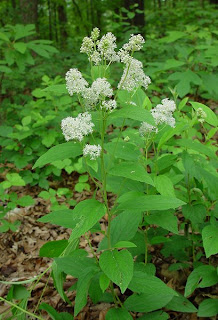SPIKENARD

Latin Name: Aralia racemosa
Alternate Names: American Spikenard, Manroot, Wild Sarsaparilla, Life-of-man, Indian Root
Family: ARALIACEAE
Parts Used: Root, rhizome.
Properties: Adaptogen, Alterative, Aromatic, Carminative, Chi Tonic, Diaphoretic, Diuretic, Expectorant, Parturient, Stimulant, Uterine Tonic.
Internal Uses: Asthma, Backache, Cough, Dysentery, Eczema, Flatulence, Gout, Labor, Premenstrual Syndrome, Rash, Rheumatism, Stomachache, Syphilis, Whooping Cough
Internal Applications: Tea, Tincture, Capsules, Syrup.
In studies Spikenard demonstrates the ability to stimulate white blood cell phagocytosis and interferon production. Used as a tonic the last few weeks of pregnancy to facilitate labor.
Internal Applications: Tea, Tincture, Capsules, Syrup.
In studies Spikenard demonstrates the ability to stimulate white blood cell phagocytosis and interferon production. Used as a tonic the last few weeks of pregnancy to facilitate labor.
Topical Uses: Bruises, Ear Infection, Fractures, Rash, Wounds
Topical Applications: Use as a poultice on bruises, wounds and fractures, as a wash for rashes, and as a salve. Juice of berry was placed in ear to treat ear infection. Ojibiwa Native Americans use root as a poultice for broken bones. Outer bark is burned as an incense.
Culinary uses: Root cooked as a vegetable. Young tips eaten as a vegetable. Used in traditional root beer drinks. Roots made into 'root beer', tonic beers and wines. Berries also made into wine.
Energetics: Sweet, Pungent, Warm.
Chemical Constituents: Essential oil (falcarinone, falcarinolene), saponins, diterpene acid, tannin, resin, choline, chlorogenic acid, ursolic acid, b-sitosterol, araloside, panaxosides.
Comments: Native to North America, this herb was used among Native American peoples. The common name Spikenard includes the species Aralia californica, Aralia nudicaulis, Aralia bicrenata, Aralia arizonica and Aralia quinquefolia, which are used interchangeably with Aralia racemosa.

